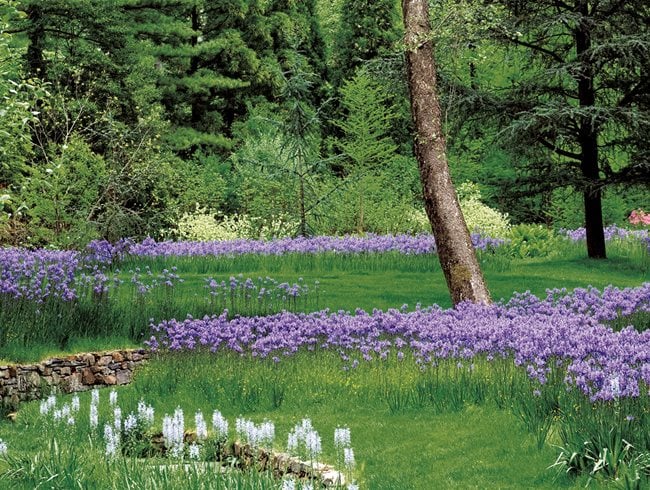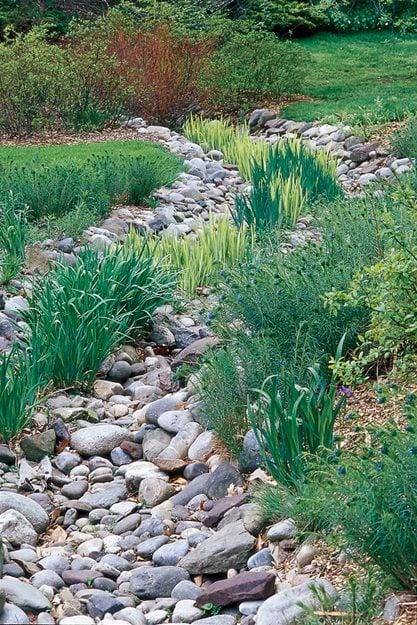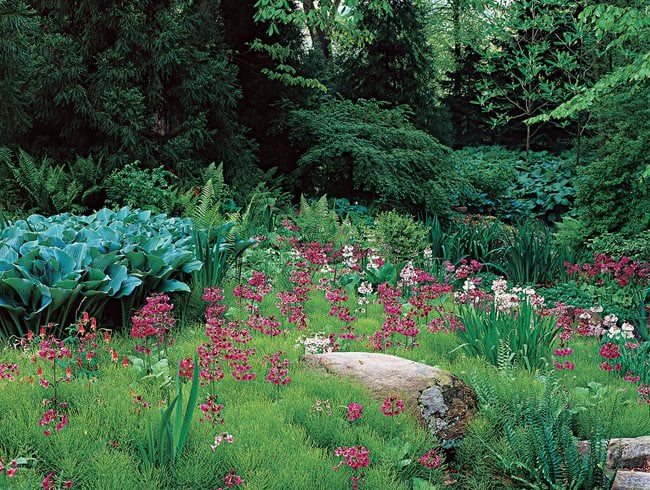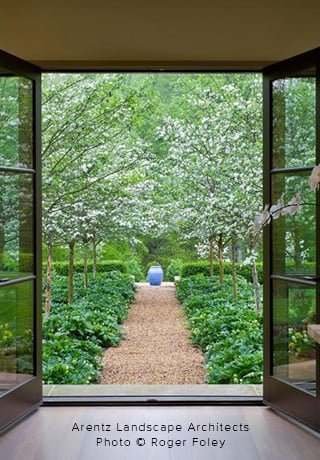Rain Garden Design, Benefits, and Plants
Well-designed rain gardens are not only good for the earth, but good-looking as wellWHAT IS A RAIN GARDEN?
A rain garden is a shallow planted depression designed to hold water until it soaks into the soil. A key feature of eco-friendly landscape design, rain gardens—also known as bio-infiltration basins—are gaining credibility and converts as an important solution to stormwater runoff and pollution. Here we’ll show you how to make a rain garden fit handsomely into a landscape and still fulfill all of its environmental functions.
Also on this page: How to Build a Rain Garden | Rain Garden Design Tips | Rain Garden Plants
On this page:

Naturalized plantings, here camassia, can make a rain garden fit easily into its surroundings. Photo by: Rob Cardillo.
Featured in: Garden Design's Top 10 Garden Trends for 2022 ("Gardening for a Changing Climate")
HOW TO BUILD A RAIN GARDEN
Create your own rain garden with these tips:
Choose a site. If you have a low area or ditch where water collects after it rains, this would be a natural spot for a rain garden. You can also redirect a downspout away from your home to divert water runoff for a rain garden. Choose a location at least 10 feet away from your home so water doesn’t seep into the foundation. The site should receive full sun to partial shade. Avoid locating your garden over a septic tank or near underground utility lines.
The ideal size of your rain garden will depend on how big your roof is, the amount of runoff generated, and your soil type. Most rain gardens average between 100 to 300 square feet. The USDA Natural Resources Conservation Service recommends an area that is 7 to 20% the size of the impervious surface creating the runoff (typically, your roof).
Prepare the site. Remove lawn or other vegetation and evaluate your native soil. Clay soil drains more slowly, while sandy soil drains more quickly. Water should drain within 12 to 48 hours of an average rainfall to keep plants healthy and mosquitos at bay.
Dig your garden. Dig a shallow basin 6 to 8 inches deep that slopes from the outer edges to the deepest point at the center. Use the removed soil to create a berm to catch and hold water runoff. Amend the soil in the basin with topsoil or compost to provide a hospitable medium for plants to grow. Create a pathway of river rocks or install an underground pipe that will divert rainwater from the downspout or other water source into the basin.
Select plants. Include native plant species that provide food and habitat for wildlife and insect pollinators. Plants should be able to tolerate moisture as well as intermittent dry spells. Include sedges, grasses, and rushes with deep root systems that will help water seep into the soil. Select a mix of plants with different foliage, texture, and flowers that bloom at different times for season-long interest. Add marginal plants that are more drought-tolerant around the perimeter such as canna lily, iris, or lobelia.
Install. Plant in larger drifts of 3 to 5 plants for greater visual impact. Water well after planting and add a layer of organic mulch to suppress weeds and retain moisture.
Maintain. Water during dry spells during the first growing season until plants are established. Prune plants according to individual requirements and clean out debris and old dead growth in spring. Divide perennials as needed once plants are mature.

Swaths of pennisetum and other grasses convert a large, shallow-draining swale into a textural garden. Photo by: Rob Cardillo.
RAIN GARDEN DESIGN TIPS
Make it part of the landscape. Think of a rain garden just like a border or foundation planting rather than a beloved specimen tree. In other words, it should not be a stand-alone feature, but integrated into the rest of the landscape.
Choose a shape. Consider all the rules of composition, screening, and circulation—not just the rule that says to put a rain garden in a low spot 10 feet from the house.
Consider style. A rain garden can be as formal or as wild as you like, but pay attention to how it looks with your home’s facade. Monocultural rain gardens are okay as long as that fits with your overall design. (See some of our favorite rain garden plants.)
Integrate with other gardens. A rain garden doesn’t have to be separate from other plantings. Consider making a depression within a perennial bed or shrub border (especially if space is tight and you don’t have room for a larger rain garden that stands alone).
Create repetition. Put in more than one rain garden for repetition and continuity. If it works with your overall design, create a little rain garden for each downspout. Or add other water features around your yard such as a fountain, birdbath, or waterfall to repeat the water theme, which is another way to lend cohesion to your landscape.
Consider aesthetics and function. Make your rain garden more attractive and user-friendly. Use decorative stones as edging, create an adjacent seating area, build an attractive pathway, or add other hardscape and accessories to make your rain garden more visually appealing.

Biostream at Scott Arboretum, Swarthmore College, collects excess rainwater, slowly filtering and releasing it into the landscape. Planted with amsonia and Iris pseudacorus, which tolerate periodic flooding. Photo by: Rob Cardillo.
Landscape architect Jim Hagstrom of Savanna Designs in Lake Elmo, Minnesota, agrees. “We integrate rain gardens into the design,” he says, “and two-thirds of the time you won’t notice them.” His designs depend mostly on his clients’ sensibilities. Some love the wild native look of a traditional rain garden, while others favor the idea of infiltration but don’t want to see a “patch of weeds.” He has incorporated a rain garden into the center of a circle drive and devised a standing stone flow-through curb to match the house. He has created a large basin that infiltrates most water then holds the rest for pond habitat. He has built rain gardens in the centers of lawns, by dishing the landscape and ensuring well-draining soil. “You get a little pond after a rain,” he describes, “and in 24 hours it’s gone, and you have the lawn back.”

Flowers of hot-pink primroses punctuate a streamside garden at Chanticleer, bringing a pop of color to the varied greens of other moisture-loving plants, such as hostas, iris, ferns, and dwarf scouring rush. Photo by: Rob Cardillo.
However they look, rain gardens work, helping to reduce storm-water waste by 99 percent, according to one study, and keeping runoff clean. But they can also be an integrated design element, making landscapes both sustainable and beautiful.
RAIN GARDEN PLANTS
Plant selection for a rain garden can be a challenge. Some popular plants that work well in rain gardens are:
- Orange coneflower (Rudbeckia fulgida)
- Switchgrass (Panicum virgatum)
- Obedient plant (Physostegia virginiana)
- Wild bergamot (Monarda fistulosa)
- Common winterberry (Ilex verticulata)
- Cardinal flower (Lobelia siphilitica)
- Goldenrod (Solidago rugosa)
See more of our favorite plants for rain gardens.
According to the EPA, much of the rain that falls on a typical city block heads overland to the nearest pipe, washing along any crud it finds. Historically that water would have infiltrated—soaked in—leaving impurities behind in the soil and plants as it passed through to replenish the water table. Rain gardens are intended to counteract both the unnatural runoff patterns in urban and suburban areas (too many roads, too much paving, too many hard surfaces) as well as the increased crud levels found in them.
Rain gardens can work in most climates, but are most effective in regions with a natural groundwater hydrology—that is, areas with deep soils that drink in water rather than rocky areas that force rain to run overland. Most of the United States is like this. Rain gardens have gained wide residential use in cities as diverse as Kansas City, Minneapolis, and Portland, Oregon (the latter two offer utility-bill discounts for rain-garden installation). Entire towns, such as Maplewood, Minnesota, have turned to rain gardens to handle neighborhood storm-water management, plunking little planted basins down between curbs and property lines.
Portions of this article were contributed by Therese Ciesinski and Janet Loughrey
RELATED:
Recovering a Flooded Garden
